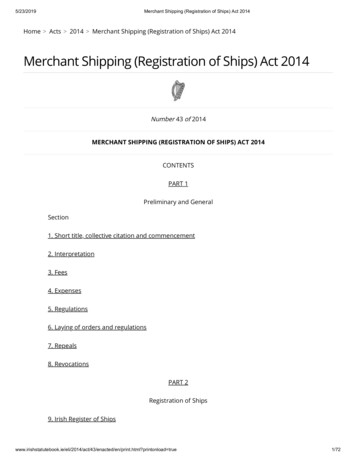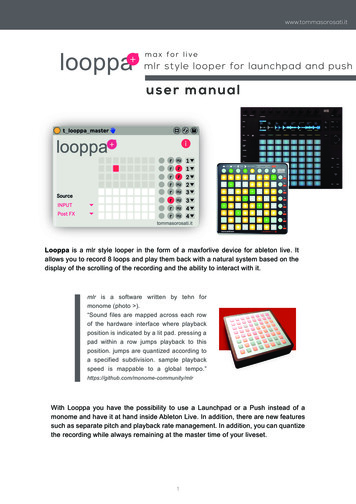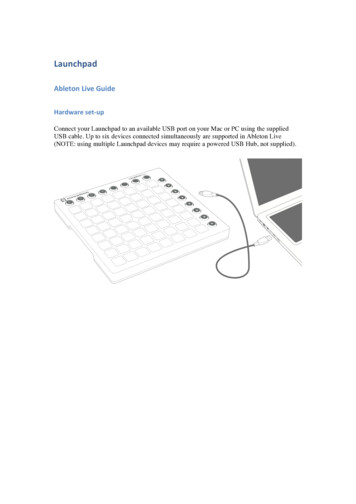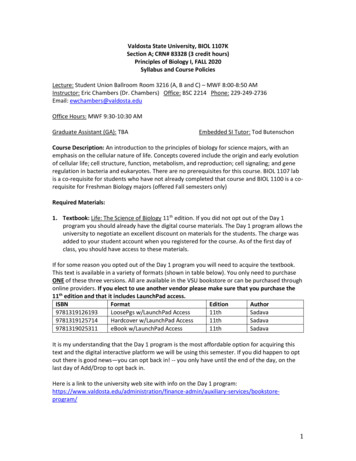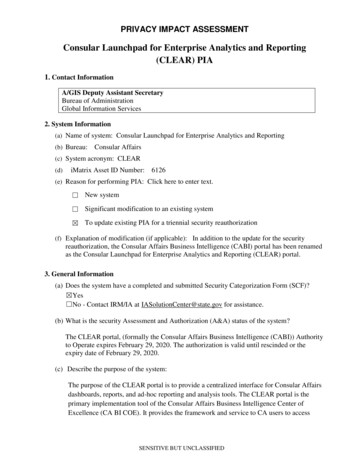
Transcription
PRIVACY IMPACT ASSESSMENTConsular Launchpad for Enterprise Analytics and Reporting(CLEAR) PIA1. Contact InformationA/GIS Deputy Assistant SecretaryBureau of AdministrationGlobal Information Services2. System Information(a) Name of system: Consular Launchpad for Enterprise Analytics and Reporting(b) Bureau:Consular Affairs(c) System acronym: CLEAR(d)iMatrix Asset ID Number:6126(e) Reason for performing PIA: Click here to enter text. New system Significant modification to an existing system To update existing PIA for a triennial security reauthorization(f) Explanation of modification (if applicable): In addition to the update for the securityreauthorization, the Consular Affairs Business Intelligence (CABI) portal has been renamedas the Consular Launchpad for Enterprise Analytics and Reporting (CLEAR) portal.3. General Information(a) Does the system have a completed and submitted Security Categorization Form (SCF)? Yes No - Contact IRM/IA at IASolutionCenter@state.gov for assistance.(b) What is the security Assessment and Authorization (A&A) status of the system?The CLEAR portal, (formally the Consular Affairs Business Intelligence (CABI)) Authorityto Operate expires February 29, 2020. The authorization is valid until rescinded or theexpiry date of February 29, 2020.(c) Describe the purpose of the system:The purpose of the CLEAR portal is to provide a centralized interface for Consular Affairsdashboards, reports, and ad-hoc reporting and analysis tools. The CLEAR portal is theprimary implementation tool of the Consular Affairs Business Intelligence Center ofExcellence (CA BI COE). It provides the framework and service to CA users to accessSENSITIVE BUT UNCLASSIFIED
CA CLEARApril 2020consular data extracted from other CA sources through the Consular Consolidated Database(CCD). The CLEAR portal pulls data from the CCD, which has data that originated fromthe following CA systems: Non-Immigrant Visa (NIV), Immigrant Visa Overseas (IVO),Consular Electronic Application Center (CEAC), American Citizen Services (ACS) suite ofsystems, and the Travel Document Issuance System (TDIS). The extracted data is thenaggregated and loaded into database structures optimized for reporting (also referred to asthe CA Enterprise Data Warehouse and data marts) or loaded into the SAP Highperformance analytic appliance (HANA) database.(d) Describe the personally identifiable information (PII) that the system collects, uses,maintains, or disseminates: Names of individuals Business contact information Personal phone numbers Personal email addresses Personal addresses Place of birth Date of birth Mother’s maiden name Social Security Number Social media accounts of individuals Government Issued IDs (e.g., passport numbers or national identification numbers of visaapplicants)(e) What are the specific legal authorities and/or agreements that allow the information to becollected? 22 U.S.C. § 3927 (Chief of Mission) 8 U.S.C. 1101-1105a; 1151-1363a;1401-1504 & 1151-1363a03 (The Immigrationand Nationality Act of 1952, as amended) 18 U.S.C. 911, 1001, 1541-1546 (Crimes and Criminal Procedure); 22 U.S.C. 211a-218, (Passports) 22 U.S.C. 2651a (Organization of Department of State) Executive Order 11295, August 5, 1966, 31 FR 10603; (Authority of the Secretary ofState in granting and issuing U.S. passports) 22 C.F.R. Parts 50 and 51 (Nationality Procedures and Passports) 26 U.S.C. 6039E (Information Concerning Residence Status) 22 C.F.R. Parts 40-42, and 46 (Visas)(f) Is the information searchable by a personal identifier (e.g., name or Social SecurityPage 2SENSITIVE BUT UNCLASSIFIED
CA CLEARApril 2020number)? Yes, provide:- SORN Name and Number:STATE-26 - Passport Records, March 24, 2015STATE-05 - Overseas Citizens Records and Other Overseas Records, September 8,2016STATE-39 Visa Records, June 15, 2018 No, explain how the information is retrieved without a personal identifier.(g) Does the existing SORN need to be amended to reflect the inclusion of this new orsignificantly modified system? Yes NoIf yes, please notify the Privacy Division at Privacy@state.gov.(h) Is there a records retention schedule submitted to or approved by the National Archives andRecords Administration (NARA) for this system? Yes No(If uncertain about this question, please contact the Department’s Records Officer atrecords@state.gov .)If yes provide:Schedule number, Length of time the information is retained in the system, and Type ofinformation retained in the system:B-09-002-02b Intermediary RecordsDescription: Immigrant Visa, Non-immigrant Visa, and Consular Consolidated Databasehard copy and electronic input records, including applications, supplemental questionnaires,refusal worksheets and supporting or related documentation and correspondence, relating topersons who have been refused immigrant or nonimmigrant visas (including quasi-refusals),under the following section(s) of law: INA subsections 212(a)(1)(A)(i), (iii), and (iv); (2);(3); (6)(c), (E), and (F); (8); (9)(A) (if alien convicted of an aggravated felony), and (C); and10(D) and (E); 222(g); Title IV of the Helms-Burton Act (22 USC 6021 et seq.); any casesrequiring the Department’s opinion code00 (Except quasi-refusal cases under (6)(C)(i));INA subsection 212(a)(10)(C); Quasi-Refusals under 212(a)(6)(C)(i); 212(a)(9)(B); INAsubsection 212(f); and Section 5(a)(1) of the Tom Lantos Block Burmese JADE (Junta’sAnti-Democratic Efforts) Act of 2008.Also includes output records such as adhoc and other reports that contain summarized oraggregated information created by combining data elements or individual observations froma single master file or database.Disposition: Temporary. Destroy upon verification of successful creation of the finaldocument or file, or when no longer needed for business use, whichever is later.Page 3SENSITIVE BUT UNCLASSIFIED
CA CLEARApril 2020DispAuthNo: DAA-GRS-2017-0003-00024. Characterization of the Information(a) What entities below are the original sources of the information in the system? Please checkall that apply. Members of the Public U.S. Government employees/Contractor employees (DoS business information toassigned privileges to access Passport systems to perform specified tasks). Other (people who are not U.S. Citizens or LPRs)(b) If the system contains Social Security Numbers (SSNs), is the collection necessary? Yes No- If yes, under what authorization?26 U.S.C. 6039E (Information Concerning Resident Status);Executive Order 9397, November 22, 1943 and Executive Order 13478, November 18, 2008(amending E.O. 9397)(c) How is the information collected?The information for the CLEAR portal reports are collected directly (database to database)from the CCD which houses information from consular systems, all of which reside outsidethe CLEAR portal system boundary. CLEAR is merely a centralized interface for varioussystems within the Bureau of Consular Affairs.(d) Where is the information housed? Department-owned equipment FEDRAMP-certified cloud Other Federal agency equipment or cloud Other- If you did not select “Department-owned equipment,” please specify.(e) What process is used to determine if the information is accurate?The CCD information comes directly from foreign individuals who are applying for visas,US citizens applying for passports, and information entered by consular officers into thesource systems. The CLEAR portal only pulls data from source systems (IVO, CEAC, NIV,ACS and TDIS) via the CCD and therefore relies on the source systems to maintain andsupply accurate data.Page 4SENSITIVE BUT UNCLASSIFIED
CA CLEARApril 2020(f) Is the information current? If so, what steps or procedures are taken to ensure it remainscurrent?Information from the CCD is current and is pulled into the CLEAR portal databases at leastonce a week.(g) Does the system use information from commercial sources? Is the information publiclyavailable?No, the CLEAR system does not acquire information from commercial sources nor is theinformation it gathers publicly available.(h) Is notice provided to the individual prior to the collection of his or her information?The CLEAR portal gets its data from other CA information systems addressed in paragraph3(c). CLEAR does not collect any data directly from any individual. Individuals areprovided notice when they provide their information to the various systems that CLEAR ispulling the information from.(i) Do individuals have the opportunity to decline to provide the information or to consent toparticular uses of the information? Yes No- If yes, how do individuals grant consent?- If no, why are individuals not allowed to provide consent?The CLEAR portal gets its data from other CA information systems addressed in paragraph3(c). CLEAR does not collect any data directly from any individual. Should individualswant to decline to provide their information, they would need to do so at the original pointof collection for the source systems.(j) How did privacy concerns influence the determination of what information would becollected by the system?CLEAR does not collect information from the public. CLEAR receives information from CAsystems listed in paragraph 3(c). CLEAR merely acts as a centralized interface for varioussystems within the Bureau of Consular Affairs. However, concerns include unauthorizedaccess, disclosure, modification, and/or misuse of the data by users and/or a security breach.These risks were considered during the system design and security configuration. The PIIcollected by CLEAR is the minimum necessary to perform the actions required by thissystem to provide a centralized interface for dashboards, reports, and ad hoc reporting andanalysis tools for CA users.Page 5SENSITIVE BUT UNCLASSIFIED
CA CLEARApril 20205. Use of information(a) What is/are the intended use(s) for the information?The information is used to generate reports and compile metrics related to consularoperations and transactions, such as visa and passport applications and applicants, so thatconsular professionals can perform various types of analyses, including fraud detection,resource allocation, and determination of the cost of services.(b) Is the use of the information relevant to the purpose for which the system was designed or forwhich it is being designed?Yes. The PII is used in the management of the visa and passport operations by CA personnelto compile metrics related to consular operations and transactions for decision makingpurposes.(c) Does the system analyze the information stored in it? Yes NoIf yes:(1) What types of methods are used to analyze the information?The reports from the CLEAR portal display metrics based on a category, comparisonsbased on trends and averages, and bring together data from different systems to showrelationships of the data.(2) Does the analysis result in new information? Yes.(3) Will the new information be placed in the individual’s record? Yes No(4) With the new information, will the Department be able to make new determinationsabout the individual that would not have been possible without it? Yes No6. Sharing of Information(a) With whom will the information be shared internally and/or externally? Please identify therecipients of the information.The main internal stakeholders are within Consular Affairs, with other Department of Statebureaus such as Diplomatic Security (DS) and the Bureau of Population, Refugees, andMigration (PRM) occasionally requesting reports from the CLEAR system. No one outsideof the Department of State has access to the CLEAR portal itself or the data within theunderlying data warehouse.Page 6SENSITIVE BUT UNCLASSIFIED
CA CLEARApril 2020(b) What information will be shared?All of the PII mentioned in 3(d) will be shared through dashboards, reports, ad hoc reportingtools, and analysis tools.(c) What is the purpose for sharing the information?Information is shared for the purpose of decision support, operational improvement,workload assessment and forecasting, resource planning, and fraud analysis andinvestigation reports for use by Consular Affairs. DS and PRM use reports for fraudanalysis and investigations in support of their missions.(d) The information to be shared is transmitted or disclosed by what methods?After the CLEAR portal manipulates the data and produces an electronic report or file, theauthorized user can then save it on a local or network drive, or send it as an emailattachment. The report can also be printed or faxed.(e) What safeguards are in place for each internal or external sharing arrangement?Supervisors along with information system security officers (ISSOs) determine the accesslevel depending on job function and level of clearance.Information is shared by secure transmission methods permitted by internal Department ofState policy for the handling and transmission of Sensitive but Unclassified (SBU)information. Access to electronic files is protected by inherited security controls from theDepartment of State domain infrastructure. All accounts are under the supervision ofsystem managers. Audit trails track and monitor usage and access. Defense in depth isdeployed as well as roles assigned based on least privilege. Finally, regularly administeredsecurity and privacy training informs authorized users of proper handling procedures.(f) What privacy concerns were identified regarding the sharing of the information? How werethese concerns addressed?Privacy concerns regarding the sharing of information focus on two primary sources of risk:1) Accidental disclosure of information to non-authorized parties:Accidental disclosure is usually due to inadequate document control (hard copy orelectronic), inadequate PII and security training, or insufficient knowledge of roles,authorization and need to know policies. In addition, social engineering, phishing,and firewall breaches can also represent a risk of accidental disclosure of information.2) Deliberate disclosure/theft or information to non-authorized parties regardless of motivewhether monetary, personal or other.Page 7SENSITIVE BUT UNCLASSIFIED
CA CLEARApril 2020These risks are mitigated using a multi-faceted approach to security:1) Frequent security training for all personnel regarding information security, includingthe safe handling and storage of PII, Sensitive but Unclassified, and all higherlevels of classification, and signing a user agreement.2) Strict role based access control, based on approved roles and responsibilities,authorization, need- to-know, and clearance level.3) Implementation of management, operational, and technical controls regarding separationof duties, least privilege, auditing, and personnel account management.7. Redress and Notification(a) What procedures allow individuals to gain access to their information?The CLEAR portal does not collect information directly from individuals nor do individualshave access to the CLEAR data. CLEAR acquires information from CCD to performfunctions.An individual would need to follow procedures outlined for the source system where theyprovided information, i.e., the CCD, to gain access to their information.Individuals may also visit the Department of State public site and/or the Department of StatePrivacy Act/FOIA website for the privacy policy which includes procedures on how toobtain access to records by contacting the listed offices by phone or by mail.(b) Are procedures in place to allow an individual to correct inaccurate or erroneousinformation? Yes NoIf yes, explain the procedures.If no, explain why not.CLEAR does not collect information directly from the public. The information is acquiredfrom other CA systems listed in paragraph 3(c). Data is copied from the original sourcesystems in a one-way pull from the source systems into the CLEAR data warehouse.Individuals must follow processes of the source systems used to apply for the specific serviceto request correction of information. Notice to correct personal information is provided at thesource site where applicants apply for specific services.Individuals can also follow procedures outlined in SORNs STATE-26, STATE-05, andSTATE 39, listed in paragraph 3(f) as above that are posted on the Department of State’sPrivacy website at www.state.gov/privacy.Page 8SENSITIVE BUT UNCLASSIFIED
CA CLEARApril 2020(c) By what means are individuals notified of the procedures to correct their information?CLEAR does not collect information from the public. The information isacquired from other CA systems listed in paragraph 3(c). Individuals must follow processesof the source systems used to apply for the specific service to request correction ofinformation. Notice to correct personal information is provided at the source site whereapplicants apply for specific services.Individuals can also follow procedures outlined in SORNs STATE-26, STATE-05 andSTATE 39 addressed in paragraph 3(f) that are posted on the Department of State’s Privacywebsite at www.state.gov/privacy.8. Security Controls(a) How is the information in the system secured?Information in the CLEAR portal is secured where risk factors are mitigated through the useof defense in depth layers of security, including management, operational and technicalsecurity controls, auditing, firewalls, physical security, and continuous monitoring. Internalaccess is limited to authorized Department of State users, including cleared contractors whohave a justified need for the information in order to perform official duties.CLEAR personnel access accounts are created and assigned the appropriate level ofprivileges approved by the supervisor. The user can then perform the tasks associated withthe privileges authorized. Additionally, CLEAR generates audit records that display timestamps, source and destination addresses, user/process identifiers, event descriptions,success/fail indications, filenames involved, and access control or flow control rules invokedfor record searches. This information is used to track Department of State user activity forauditing. Audit Trail Reports can be run to show reports that were executed/ accessed byusers at any time. Screen shots depict access for a specific date/time to a file, along with thelist of users and their transactions.CLEAR is configured according to State Department Security Configuration Guides tooptimize security while still providing functionality. Applicable National Institute ofStandards and Technology (NIST) 800-53 and privacy overlays of management, operational,and technical controls are in place and are tested as part of the continuous monitoringprogram. Vulnerabilities noted during the testing of the system are reported appropriatelyand are tracked until compliant or acceptably mitigated.(b) Describe the procedures established to limit access to only those individuals who have an“official” need to access the information in their work capacity.Page 9SENSITIVE BUT UNCLASSIFIED
CA CLEARApril 2020Access to information within the CLEAR portal is role based and controlled by BusinessObjects security groups. Each report within the CLEAR portal is assigned to a BusinessObjects security group. Each security group is also associated with either an ActiveDirectory group or role in an external system. For a user to access a report, they must bepart of the specific Active Directory (AD) group or have the external role associated withthe Business Objects security group. The AD groups and external roles associated with thereport are determined by the Business Units.Access to the information in the system is role based, and restricted according to approvedjob responsibilities and requires managerial concurrence. Access control lists permitcategories of information and reports to be restricted. Information System Security Officersdetermine the access level needed by a user (including managers) to ensure it correlates tothe user’s particular job function and level of clearance.(c) What monitoring, recording, and auditing safeguards are in place to prevent the misuse ofthe information?Various technical controls are in place to deter, detect, and defend against the misuse ofpersonally identifiable information (PII). Any changes (authorized or not) that occur to dataare recorded. In accordance with Department of State Security Configuration Guides,auditing is also enabled for this specific system to track the following events on the hostoperating systems, and back-end database servers: Multiple logon failures;Logons after hours or at unusual times;Failed attempts to execute programs or access files;Addition, deletion, or modification of user or program access privileges; orChanges in file access restrictions.The purpose of the CLEAR audit trail is to document unintended modification orunauthorized access to the system and to dynamically audit retrieval access to designatedcritical data. If an issue were to arise, administrators of the system would review (audit) thelogs that were collected from the time a user logged on until the time he/she signed off.This multilayered approach to security controls greatly reduces the risk that PII will bemisused.(d) Explain the privacy training provided to the authorized users of the system.Page 10SENSITIVE BUT UNCLASSIFIED
CA CLEARApril 2020(e) Are any security controls, such as encryption, strong authentication procedures, or othercontrols, in place to make the information unusable to unauthorized users? Yes NoIf yes, please explain.Routine monitoring, testing, and evaluation of security controls are conducted to ensure thesafeguards continue to function as desired. Many of the security controls implemented tomake information unusable or inaccessible to unauthorized users include accessenforcement, separation of duties, least privilege, audit review, analysis, and reporting,identification and authentication of organizational users, information system monitoringand numerous media controls.The Information Integrity Branch (IIB) provides administrative life-cycle securityprotection for the Department of State's information technology systems and informationresources. All systems must comply with all guidelines published by Systems IntegrityDivision, in addition to all Security Configuration Guides published by DiplomaticSecurity. Adherence to these guides is verified during the system’s Assessment andAuthorization process.The CLEAR uses Transmission Control Protocol/Internet Protocol (TCP/IP) for datatransport across the network. Data in transit is encrypted. The TCP/IP suite consists ofmultiple layers of protocols that help ensure the integrity of data transmission, includinghandshaking, header checks, and re-sending of data if necessary.(f) How were the security measures above influenced by the type of information collected?The information in CLEAR contains PII of U.S. citizens, legal permanent Residents (LPRs)and foreigners. Due to the sensitivity of information collected, information is secured byeffective procedures for access authorization, account housekeeping, monitoring, recording,and auditing.Page 11SENSITIVE BUT UNCLASSIFIED
CA CLEARApril 2020Organizations or individuals whose PII is breached or exposed to unauthorized users couldface inconvenience, distress, damage to standing or reputation, threats to personal safety, andfinancial loss. Security measures are in place to minimize these risks, and to minimize therisk of harm to State Department programs or the public interest through an unauthorizedrelease of sensitive information. The security measures listed above in paragraph 8(e) areimplemented to secure the data in the system in compliance with federal laws and policies,including Department policies.9. Data Access(a) Who has access to data in the system?The following personnel have access to these systems:System Administrator: System administrative staff maintain the system and user accounts,perform system backups, control access control lists, manage the operating system changesand other actions to keep CLEAR operational. They have the same security responsibilities ofusers, but their responsibilities are expanded to recognize their privileged user status. Systemsadministrators restrict themselves from using their position to turn off/destroy audit trails,giving unauthorized individuals privileged access, and modifying the system to negateautomated security mechanisms.Database Administrator: The Database Administrator performs maintenance, troubleshootstechnical issues, installs software and patches, and other actions needed to keep the systemoperational.Application Security Manager: Security Managers administer and monitor the activities toprotect the system. The Application Security Manager utilizes the Central ManagementConsole to manage user access levels. The Application Security Manager, responsible forgranting users access to application specific data via reports and dashboards, employs theneed to know policy to enforce the most restrictive set of rights/privileges needed by users toperform their job.CA Users - Access to CLEAR is restricted to cleared Department of State direct hire andcontractor employees. The CLEAR users are assigned access privileges based on their jobfunctions. All access is enforced by user profiles according to the principle of least privilegeand the concept of separation of duties. Users: Authorized individuals who acquirePage 12SENSITIVE BUT UNCLASSIFIED
CA CLEARApril 2020information from CLEAR to perform duties using generated reports dashboards, ad hocreporting tools, and analysis tools.All access permissions are enforced by Business Objects groups according to the principle ofleast privilege and the concept of separation of duties. Business Objects groups are populatedby linking them to an external authoritative source (Active Directory group or externalapplication role).(b) How is access to data in the system determined?User access to information is restricted according to job responsibilities and requiresmanagerial level approvals. Access control lists permit categories of information and reportsthat are to be restricted. Information System Security Officers determine the access levelneeded by a user (including managers) to ensure it correlates to the user’s particular jobfunction and level of clearance.(c) Are procedures, controls or responsibilities regarding access to data in the systemdocumented? Yes NoProcedures and controls are documented in the System Security Plan. The Plan includesinformation and procedures regarding access to data in the CLEAR portal.(d) Will all users have access to all data in the system, or will user access be restricted? Pleaseexplain.No, all users will not have access to all data in the system. The CLEAR portal has a veryrestrictive policy regarding accessing sensitive data. There is a process is in place wherebyeach Business Unit must define requirements and authorize users for all reports from CLEARfor which they are the data owners.(e) What controls are in place to prevent the misuse (e.g. unauthorized browsing) of data by usershaving access to the data? The CLEAR system information is protected by multiple layers ofsecurity controls including:Page 13SENSITIVE BUT UNCLASSIFIED
CA CLEARApril 2020- Access control policies and access enforcement mechanisms control access to PII.- Separation of duties is implemented; access is role based as required by Department of Statepolicy.- CLEAR System and Database Administrators, the Application Security Manager and internalusers must use dual factor authentication utilizing Personal IdentificationVerification/Common Access Card (PIV/CAC) and Personal Identification Number (PIN) toaccess data. Users are uniquely identified and authenticated before accessing PII and whilelogged in can be traced to their actions performed.- Least Privileges are restrictive rights/privileges or access of users for theperformance of specified tasks. The Department of State ensures that users who must accessrecords containing PII only have access to the minimum amount of PII, along with onlythose privileges (e.g., read, write, execute) that are necessary to perform their job duties.- System and information integrity auditing are implemented to monitor and recordunauthorized access/use of information.Page 14SENSITIVE BUT UNCLASSIFIED
Information is shared for the purpose of decision support, operational improvement, workload assessment and forecasting, resource planning, and fraud analysis and investigation reports for use by Consular Affairs. DS and PRM use reports for fraud analysis and investigations in support of their missions.
